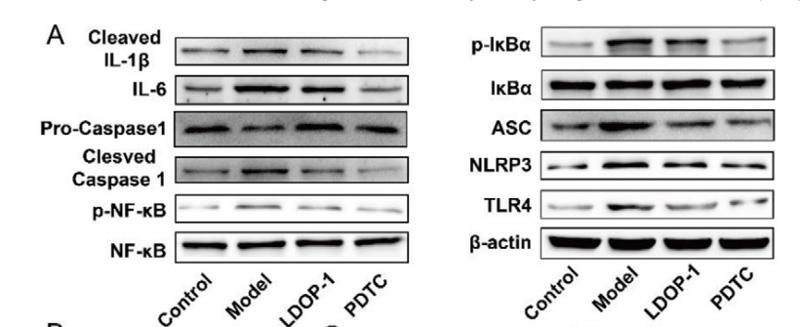FGA Antibody - #DF7895
| 製品: | FGA Antibody |
| カタログ: | DF7895 |
| タンパク質の説明: | Rabbit polyclonal antibody to FGA |
| アプリケーション: | WB IHC |
| Cited expt.: | WB |
| 反応性: | Human, Rat |
| 予測: | Chicken, Xenopus |
| 分子量: | 95 kDa; 95kD(Calculated). |
| ユニプロット: | P02671 |
| RRID: | AB_2841316 |
製品説明
*The optimal dilutions should be determined by the end user. For optimal experimental results, antibody reuse is not recommended.
*Tips:
WB: For western blot detection of denatured protein samples. IHC: For immunohistochemical detection of paraffin sections (IHC-p) or frozen sections (IHC-f) of tissue samples. IF/ICC: For immunofluorescence detection of cell samples. ELISA(peptide): For ELISA detection of antigenic peptide.
引用形式: Affinity Biosciences Cat# DF7895, RRID:AB_2841316.
折りたたみ/展開
Ac1873; Fba5e; FGA; Fib; Fib2; FIBA_HUMAN; Fibrinogen alpha chain; Fibrinogen, A alpha polypeptide; Fibrinogen--alpha polypeptide chain; Fibrinopeptide A;
免疫原
A synthesized peptide derived from human FGA, corresponding to a region within C-terminal amino acids.
- P02671 FIBA_HUMAN:
- Protein BLAST With
- NCBI/
- ExPASy/
- Uniprot
MFSMRIVCLVLSVVGTAWTADSGEGDFLAEGGGVRGPRVVERHQSACKDSDWPFCSDEDWNYKCPSGCRMKGLIDEVNQDFTNRINKLKNSLFEYQKNNKDSHSLTTNIMEILRGDFSSANNRDNTYNRVSEDLRSRIEVLKRKVIEKVQHIQLLQKNVRAQLVDMKRLEVDIDIKIRSCRGSCSRALAREVDLKDYEDQQKQLEQVIAKDLLPSRDRQHLPLIKMKPVPDLVPGNFKSQLQKVPPEWKALTDMPQMRMELERPGGNEITRGGSTSYGTGSETESPRNPSSAGSWNSGSSGPGSTGNRNPGSSGTGGTATWKPGSSGPGSTGSWNSGSSGTGSTGNQNPGSPRPGSTGTWNPGSSERGSAGHWTSESSVSGSTGQWHSESGSFRPDSPGSGNARPNNPDWGTFEEVSGNVSPGTRREYHTEKLVTSKGDKELRTGKEKVTSGSTTTTRRSCSKTVTKTVIGPDGHKEVTKEVVTSEDGSDCPEAMDLGTLSGIGTLDGFRHRHPDEAAFFDTASTGKTFPGFFSPMLGEFVSETESRGSESGIFTNTKESSSHHPGIAEFPSRGKSSSYSKQFTSSTSYNRGDSTFESKSYKMADEAGSEADHEGTHSTKRGHAKSRPVRDCDDVLQTHPSGTQSGIFNIKLPGSSKIFSVYCDQETSLGGWLLIQQRMDGSLNFNRTWQDYKRGFGSLNDEGEGEFWLGNDYLHLLTQRGSVLRVELEDWAGNEAYAEYHFRVGSEAEGYALQVSSYEGTAGDALIEGSVEEGAEYTSHNNMQFSTFDRDADQWEENCAEVYGGGWWYNNCQAANLNGIYYPGGSYDPRNNSPYEIENGVVWVSFRGADYSLRAVRMKIRPLVTQ
種類予測
Score>80(red) has high confidence and is suggested to be used for WB detection. *The prediction model is mainly based on the alignment of immunogen sequences, the results are for reference only, not as the basis of quality assurance.
High(score>80) Medium(80>score>50) Low(score<50) No confidence
研究背景
Cleaved by the protease thrombin to yield monomers which, together with fibrinogen beta (FGB) and fibrinogen gamma (FGG), polymerize to form an insoluble fibrin matrix. Fibrin has a major function in hemostasis as one of the primary components of blood clots. In addition, functions during the early stages of wound repair to stabilize the lesion and guide cell migration during re-epithelialization. Was originally thought to be essential for platelet aggregation, based on in vitro studies using anticoagulated blood. However, subsequent studies have shown that it is not absolutely required for thrombus formation in vivo. Enhances expression of SELP in activated platelets via an ITGB3-dependent pathway. Maternal fibrinogen is essential for successful pregnancy. Fibrin deposition is also associated with infection, where it protects against IFNG-mediated hemorrhage. May also facilitate the immune response via both innate and T-cell mediated pathways.
The alpha chain is normally not N-glycosylated, even though glycosylation at Asn-686 was observed when a fragment of the protein was expressed in insect cells. It is well known that heterologous expression of isolated domains can lead to adventitious protein modifications. Besides, glycosylation at Asn-686 is supported by large-scale glycoproteomics studiesand, but the evidence is still quite tenuous. Most likely, Asn-686 is not glycosylated in the healthy human body, or only with low efficiency.
O-glycosylated.
Forms F13A-mediated cross-links between a glutamine and the epsilon-amino group of a lysine residue, forming fibronectin-fibrinogen heteropolymers.
About one-third of the alpha chains in the molecules in blood were found to be phosphorylated.
Conversion of fibrinogen to fibrin is triggered by thrombin, which cleaves fibrinopeptides A and B from alpha and beta chains, and thus exposes the N-terminal polymerization sites responsible for the formation of the soft clot. The soft clot is converted into the hard clot by factor XIIIA which catalyzes the epsilon-(gamma-glutamyl)lysine cross-linking between gamma chains (stronger) and between alpha chains (weaker) of different monomers.
Phosphorylated by FAM20C in the extracellular medium.
Secreted.
Detected in blood plasma (at protein level).
A long coiled coil structure formed by 3 polypeptide chains connects the central nodule to the C-terminal domains (distal nodules). The long C-terminal ends of the alpha chains fold back, contributing a fourth strand to the coiled coil structure.
研究領域
· Organismal Systems > Immune system > Complement and coagulation cascades. (View pathway)
· Organismal Systems > Immune system > Platelet activation. (View pathway)
参考文献
Application: WB Species: human Sample: kidney
Restrictive clause
Affinity Biosciences tests all products strictly. Citations are provided as a resource for additional applications that have not been validated by Affinity Biosciences. Please choose the appropriate format for each application and consult Materials and Methods sections for additional details about the use of any product in these publications.
For Research Use Only.
Not for use in diagnostic or therapeutic procedures. Not for resale. Not for distribution without written consent. Affinity Biosciences will not be held responsible for patent infringement or other violations that may occur with the use of our products. Affinity Biosciences, Affinity Biosciences Logo and all other trademarks are the property of Affinity Biosciences LTD.


